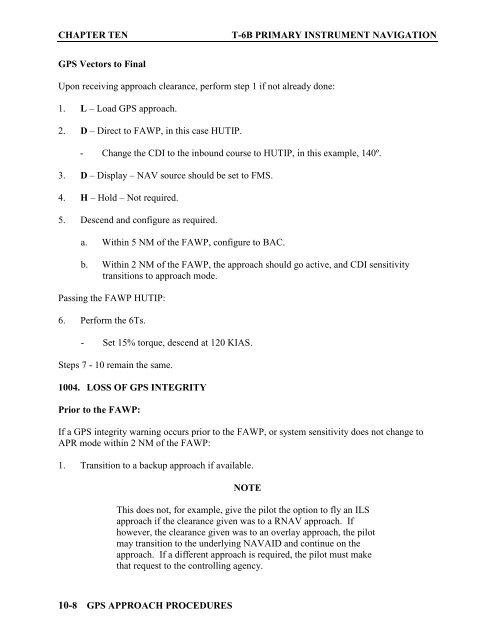Flight Training Instruction - Cnatra - U.S. Navy
Flight Training Instruction - Cnatra - U.S. Navy
Flight Training Instruction - Cnatra - U.S. Navy
You also want an ePaper? Increase the reach of your titles
YUMPU automatically turns print PDFs into web optimized ePapers that Google loves.
CHAPTER TEN T-6B PRIMARY INSTRUMENT NAVIGATION<br />
GPS Vectors to Final<br />
Upon receiving approach clearance, perform step 1 if not already done:<br />
1. L – Load GPS approach.<br />
2. D – Direct to FAWP, in this case HUTIP.<br />
- Change the CDI to the inbound course to HUTIP, in this example, 140º.<br />
3. D – Display – NAV source should be set to FMS.<br />
4. H – Hold – Not required.<br />
5. Descend and configure as required.<br />
a. Within 5 NM of the FAWP, configure to BAC.<br />
b. Within 2 NM of the FAWP, the approach should go active, and CDI sensitivity<br />
transitions to approach mode.<br />
Passing the FAWP HUTIP:<br />
6. Perform the 6Ts.<br />
- Set 15% torque, descend at 120 KIAS.<br />
Steps 7 - 10 remain the same.<br />
1004. LOSS OF GPS INTEGRITY<br />
Prior to the FAWP:<br />
If a GPS integrity warning occurs prior to the FAWP, or system sensitivity does not change to<br />
APR mode within 2 NM of the FAWP:<br />
1. Transition to a backup approach if available.<br />
10-8 GPS APPROACH PROCEDURES<br />
NOTE<br />
This does not, for example, give the pilot the option to fly an ILS<br />
approach if the clearance given was to a RNAV approach. If<br />
however, the clearance given was to an overlay approach, the pilot<br />
may transition to the underlying NAVAID and continue on the<br />
approach. If a different approach is required, the pilot must make<br />
that request to the controlling agency.
















